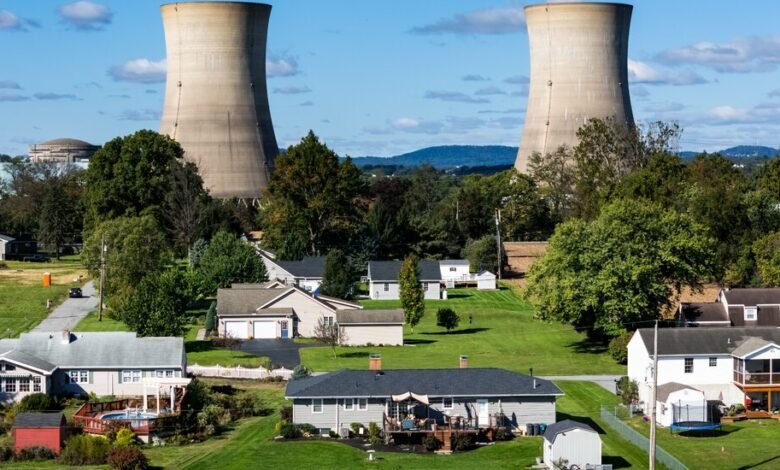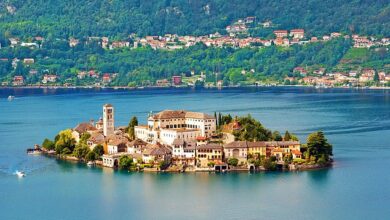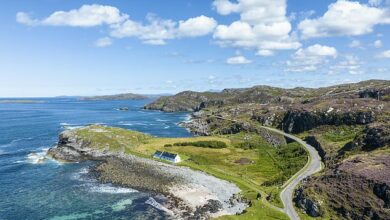Nuclear power was once shunned during climate talks. Now it is a rising star.

For years, nuclear energy was seen by many at global climate summits as part of the problem, not part of the solution.
Sama Bilbao y Leon has attended the annual United Nations climate conferences since 1999, when she studied nuclear energy. And for most of that time, she said, people didn’t want to talk about nuclear power at all.
“We had anti-nuclear groups saying, ‘What are you doing here? Go away! ” she said.
Nowadays it’s a completely different story.
At last year’s climate conference in the United Arab Emirates, 22 countries pledged for the first time to triple global use of nuclear energy by mid-century to help curb global warming. At this year’s summit in Azerbaijan six more countries signed the pledge.
“It’s a very different dynamic today,” said Dr. Bilbao y Leon, who now heads the World Nuclear Association, an industry trade group. “Many more people are open to talking about nuclear energy as a solution.”
The list of countries promising to build new nuclear reactors, which can generate electricity without emitting any planet-warming greenhouse gases, also includes longtime users of the technology, such as Canada, France, South Korea and the United States. But it also includes countries that currently have no nuclear capacity, such as Kenya, Mongolia and Nigeria.
In recent years, interest in nuclear energy has grown steadily, coupled with concerns about global warming. That shift is clearly visible during these UN climate talks, known as COP29. Along with the chants of vegan activists and the solar power booths that have enlivened previous summits, countries like Turkey and Britain are now organizing panels on how to finance new nuclear power stations or how small reactors can generate the heat needed for all kinds of industrial purposes.
Nuclear energy still has many opponents, including environmentalists who point to the high costs of the technology and radioactive waste. Yet many politicians at this year’s climate talks seem keen to revisit it.
“It gives me hope that nuclear energy is becoming increasingly popular around the world,” Czech Prime Minister Petr Fiala said in a speech to other leaders this week. “I am convinced that nuclear energy is essential to achieve climate goals.”
The interest was driven by several factors. In Britain and the United States, politicians and companies looking to phase out fossil fuels say they need a stable source of carbon-free electricity to supplement solar and wind energy, which are not available at all hours. In Eastern Europe, many countries are looking for alternatives to Russian gas.
Elsewhere, some developing countries see nuclear power as crucial to cleaning up air pollution and meeting rising energy demands.
Turkey is increasing the use of renewable energy and improving energy efficiency, but “it is not enough,” said Abdullah Bugrahan Karaveli, chairman of the country’s Energy and Nuclear Agency. The country’s electricity consumption is growing at about 4 percent a year, he said, and “we cannot do this without nuclear power in our long-term plan.”
Although Turkey currently has no operating nuclear power plants, construction is underway on the country’s first plant along the southern coast. are in discussions with Russia, China and South Korea to build a second and third factory.
Yet the obstacles are enormous. Over the past twenty years, the amount of electricity generated by nuclear power plants worldwide has increased has largely leveled off. Many countries have been deterred by the delays and rising costs that often plague efforts to build new reactors. Others, such as Germany and Japan, have closed reactors due to public opposition and fear of accidents.
Critics have called the promise to triple nuclear capacity is ‘pointless’, with doubts whether this can ever be done affordably or safely.
“We need to be practical and work on real problems,” said Shinichi Kihara, a senior official at Japan’s Ministry of Economy, Trade and Industry. “Nuclear projects in particular are often faced with uncertainty about future cost overruns.”
The Biden administration has been particularly active in promoting nuclear energy during the talks. The White House on Tuesday issue a detailed roadmap on how the country could triple its nuclear capacity by 2050.
Later that week, the board signed a letter of intent to provide for this a loan of approximately $979 million on a project in Poland that would build three large new nuclear reactors designed by Westinghouse, an American company.
Jake Levine, the senior director for climate and energy at the White House, said the United States was interested in expanding the use of nuclear power in Eastern Europe to help countries avoid dependence on Russian gas.
Nuclear power, he said, offers “a clear energy security value for many of our partners and allies.” And although President Biden will leave office in January, Mr. Levine said efforts to promote U.S. nuclear technology abroad had “strong bipartisan support” in Congress.
One American ally in Eastern Europe, Romania, already gets a fifth of its electricity from two large reactors. The country is now in talks with Western countries about reviving two other reactors that were partly built on the same site but never completed.
At the same time, an Oregon-based startup called NuScale plans to build six smaller reactors in Romania. backed by a US government loan. Some experts think a new generation of smaller reactors may be easier to finance than traditional large reactors, although the technology is still unproven.
One hurdle for Romania: Many of the country’s nuclear workers have left for the United Arab Emirates, which recently built a massive nuclear power plant and can pay higher salaries.
“Yet there is clear momentum for nuclear energy,” said Andrei Covatariu, senior research associate at the Energy Policy Group, a Romanian think tank. “It’s not a topic that just disappears.”
Dr. Leon y Bilbao said financing is still a major challenge for nuclear projects. For example, the World Bank has not financed a nuclear project since 1959. But the pressure is growing.
“It’s one thing for me to tell the World Bank to support nuclear energy,” she said. “But when there are dozens of countries, including emerging countries, saying we are interested in this, that’s a little different.”
Outside the closed negotiating rooms in Baku, where diplomats and experts tried to reach an agreement on providing climate aid to developing countries, there were demonstrations for and against nuclear energy this week.
On Thursday, a group of several dozen protesters held signs with slogans such as “Don’t Nuke the Climate” and “Stop Nuclear.”
“Nuclear energy is not clean energy if you take into account the production of minerals and the pollution it sometimes causes,” said Ivonne Yanez, president of Acción Ecológica, a nonprofit environmental organization based in Ecuador. “We have to stop using nuclear energy.”
Elsewhere in the room, a group of young nuclear professionals called Nuclear energy for the climate held their own demonstration. Two of them dressed as polar bears and danced while holding up an atomic symbol while others handed out bananas to a curious crowd.
A banana contains the same amount of radiation as someone would get if they lived next to a well-maintained nuclear power plant for a year, someone said.
The group has been around since the 2015 climate summit, where the Paris Agreement was signed. “Initially we were very small,” says Hugo Bernat, 27, a nuclear engineer based in Brussels. “But the movement is growing.”
David Gelles reporting contributed.




